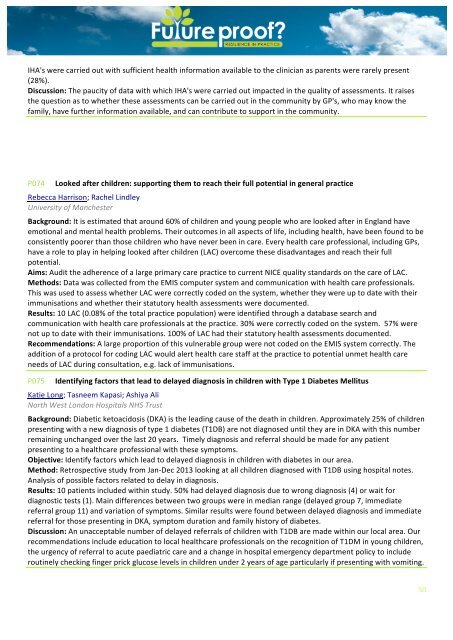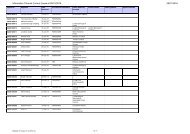RCGP-2014-poster-abstracts
RCGP-2014-poster-abstracts
RCGP-2014-poster-abstracts
You also want an ePaper? Increase the reach of your titles
YUMPU automatically turns print PDFs into web optimized ePapers that Google loves.
IHA's were carried out with sufficient health information available to the clinician as parents were rarely present <br />
(28%). <br />
Discussion: The paucity of data with which IHA's were carried out impacted in the quality of assessments. It raises <br />
the question as to whether these assessments can be carried out in the community by GP's, who may know the <br />
family, have further information available, and can contribute to support in the community. <br />
P074 <br />
Looked after children: supporting them to reach their full potential in general practice <br />
Rebecca Harrison; Rachel Lindley <br />
University of Manchester <br />
Background: It is estimated that around 60% of children and young people who are looked after in England have <br />
emotional and mental health problems. Their outcomes in all aspects of life, including health, have been found to be <br />
consistently poorer than those children who have never been in care. Every health care professional, including GPs, <br />
have a role to play in helping looked after children (LAC) overcome these disadvantages and reach their full <br />
potential. <br />
Aims: Audit the adherence of a large primary care practice to current NICE quality standards on the care of LAC. <br />
Methods: Data was collected from the EMIS computer system and communication with health care professionals. <br />
This was used to assess whether LAC were correctly coded on the system, whether they were up to date with their <br />
immunisations and whether their statutory health assessments were documented. <br />
Results: 10 LAC (0.08% of the total practice population) were identified through a database search and <br />
communication with health care professionals at the practice. 30% were correctly coded on the system. 57% were <br />
not up to date with their immunisations. 100% of LAC had their statutory health assessments documented. <br />
Recommendations: A large proportion of this vulnerable group were not coded on the EMIS system correctly. The <br />
addition of a protocol for coding LAC would alert health care staff at the practice to potential unmet health care <br />
needs of LAC during consultation, e.g. lack of immunisations. <br />
P075 <br />
Identifying factors that lead to delayed diagnosis in children with Type 1 Diabetes Mellitus <br />
Katie Long; Tasneem Kapasi; Ashiya Ali <br />
North West London Hospitals NHS Trust <br />
Background: Diabetic ketoacidosis (DKA) is the leading cause of the death in children. Approximately 25% of children <br />
presenting with a new diagnosis of type 1 diabetes (T1DB) are not diagnosed until they are in DKA with this number <br />
remaining unchanged over the last 20 years. Timely diagnosis and referral should be made for any patient <br />
presenting to a healthcare professional with these symptoms. <br />
Objective: Identify factors which lead to delayed diagnosis in children with diabetes in our area. <br />
Method: Retrospective study from Jan-‐Dec 2013 looking at all children diagnosed with T1DB using hospital notes. <br />
Analysis of possible factors related to delay in diagnosis. <br />
Results: 10 patients included within study. 50% had delayed diagnosis due to wrong diagnosis (4) or wait for <br />
diagnostic tests (1). Main differences between two groups were in median range (delayed group 7, immediate <br />
referral group 11) and variation of symptoms. Similar results were found between delayed diagnosis and immediate <br />
referral for those presenting in DKA, symptom duration and family history of diabetes. <br />
Discussion: An unacceptable number of delayed referrals of children with T1DB are made within our local area. Our <br />
recommendations include education to local healthcare professionals on the recognition of T1DM in young children, <br />
the urgency of referral to acute paediatric care and a change in hospital emergency department policy to include <br />
routinely checking finger prick glucose levels in children under 2 years of age particularly if presenting with vomiting. <br />
50



